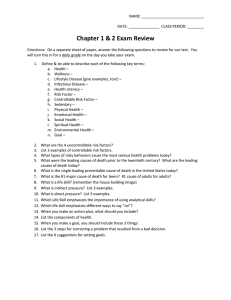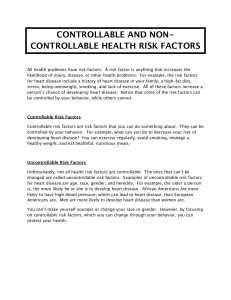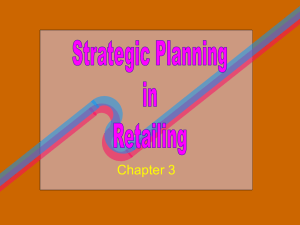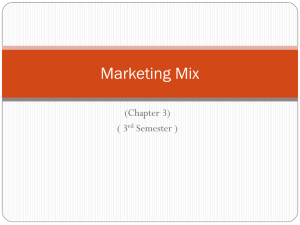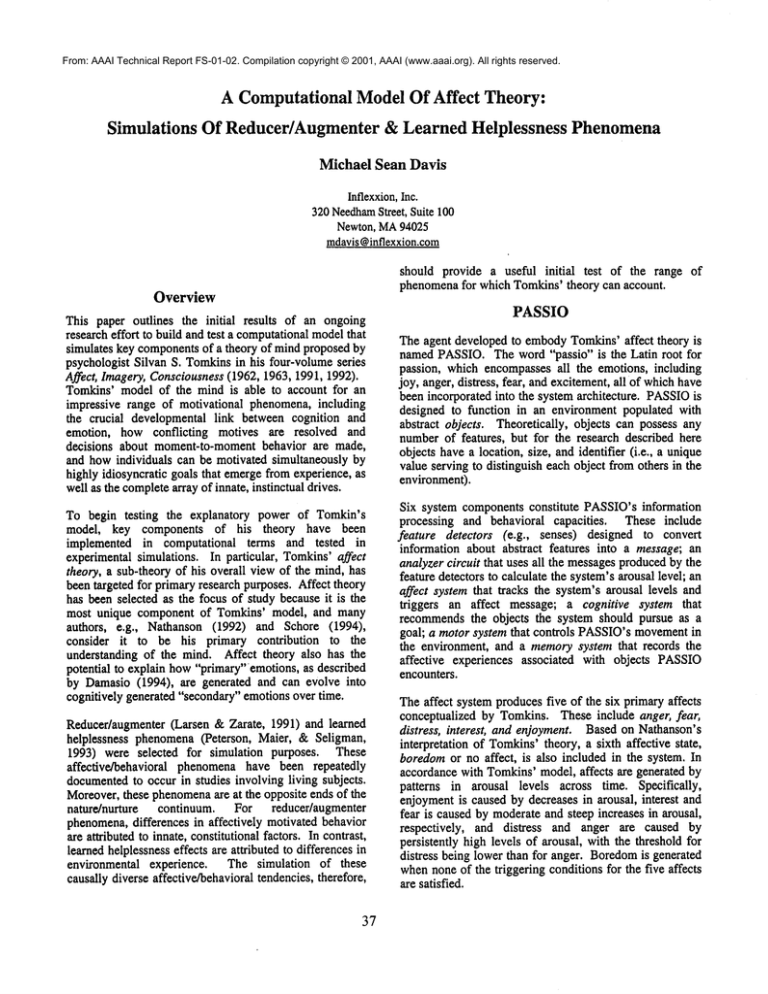
From: AAAI Technical Report FS-01-02. Compilation copyright © 2001, AAAI (www.aaai.org). All rights reserved.
A Computational Model Of Affect Theory:
Simulations Of Reducer/Augmenter& Learned Helplessness
Michael
Phenomena
Sean Davis
Inflexxion,Inc.
320 Needham
Street, Suite 100
Newton, MA94025
mdavis@inflexxion.com
should provide a useful initial test of the range of
phenomenafor which Tomkins’ theory can account.
Overview
This paper outlines the initial results of an ongoing
research effort to build and test a computationalmodelthat
simulates key componentsof a theory of mind proposed by
psychologist Silvan S. Tomkinsin his four-volume series
Affect, Imagery, Consciousness(1962, 1963, 1991, 1992).
Tomkins’ model of the mind is able to account for an
impressive range of motivational phenomena, including
the crucial developmental link between cognition and
emotion, how conflicting
motives are resolved and
decisions about moment-to-momentbehavior are made,
and how individuals can be motivated simultaneously by
highly idiosyncratic goals that emergefrom experience, as
well as the completearray of innate, instinctual drives.
To begin testing the explanatory power of Tomkin’s
model, key components of his theory have been
implemented in computational terms and tested in
experimental simulations. In particular, Tomkins’affect
theory, a sub-theory of his overall view of the mind, has
been targeted for primary research purposes. Affect theory
has been selected as the focus of study because it is the
most unique component of Tomkins’ model, and many
authors, e.g., Nathanson (1992) and Schore (1994),
consider it to be his primary contribution
to the
understanding of the mind. Affect theory also has the
potential to explain how"primary" emotions, as described
by Damasio (1994), are generated and can evolve into
cognitively generated "secondary" emotions over time.
Reducer/augmenter (Larsen & Zarate, 1991) and learned
helplessness phenomena(Peterson, Maier, & Seligman,
1993) were selected for simulation purposes. These
affective/behavioral
phenomenahave been repeatedly
documentedto occur in studies involving living subjects.
Moreover,these phenomenaare at the opposite ends of the
nature/nurture
continuum. For reducer/augmenter
phenomena,differences in affectively motivated behavior
are attributed to innate, constitutional factors. In contrast,
learned helplessness effects are attributed to differences in
environmental experience. The simulation of these
causally diverse affective/behavioral tendencies, therefore,
37
PASSIO
The agent developed to embodyTomkins’affect theory is
named PASSIO.The word "passio" is the Latin root for
passion, which encompasses all the emotions, including
joy, anger, distress, fear, and excitement, all of whichhave
been incorporated into the system architecture. PASSIOis
designed to function in an environment populated with
abstract objects. Theoretically, objects can possess any
number of features, but for the research described here
objects have a location, size, and identifier (i.e., a unique
value serving to distinguish each object from others in the
environment).
Six system components constitute PASSIO’sinformation
processing and behavioral capacities.
These include
feature detectors (e.g., senses) designed to convert
information about abstract features into a message; an
analyzer circuit that uses all the messagesproducedby the
feature detectors to calculate the system’sarousal level; an
affect system that tracks the system’s arousal levels and
triggers an affect message; a cognitive system that
recommendsthe objects the system should pursue as a
goal; a motor system that controls PASSIO’smovementin
the environment, and a memorysystem that records the
affective experiences associated with objects PASSIO
encounters.
The affect system produces five of the six primary affects
conceptualized by Tomkins. These include anger, fear,
distress, interest, and enjoyment. Based on Nathanson’s
interpretation of Tomkins’theory, a sixth affective state,
boredomor no affect, is also included in the system. In
accordance with Tomkins’model, affects are generated by
patterns in arousal levels across time. Specifically,
enjoymentis caused by decreases in arousal, interest and
fear is caused by moderate and steep increases in arousal,
respectively,
and distress and anger are caused by
persistently high levels of arousal, with the threshold for
distress being lower than for anger. Boredomis generated
whennone of the triggering conditions for the five affects
are satisfied.
The memorysystem records the affective experiences and
familiarity data associated with the objects that PASSIO
encounters. Wheneverthe distance between PASSIOand
an object is less than a specified threshold, the updating
procedures for the memorysystem axe activated. PASSIO
maintains data on the numberof times it has encountered
each object, as well as five different affective strength
values (i.e., one for each affect). Affective strength values
are updated using a modified version of the Widrow-Hoff
technique outlined by Wilson (1995) based on the active
affect at the time of each encounter.
PASS/O’scognitive system is limited to one primary task:
selecting goals for the system to pursue in the form of
objects. The cognitive system consists of four simple
stochastic modules, each one named for the type of
behavioral activity it is intended to produce. These
modules are withdraw, engage, familiarize, and explore.
All the moduleshave specific affective triggers: enjoyment
activates familiarize, interest activates explore, any of the
negative affects activates withdrawal, and boredom
activates engage. Each moduleuses distinctive criteria for
selecting goals designed to maximize the system’s
experienced ratio of positive to negative affect based on
the inherent logic of Tomkin’smodel. That is, withdraw
biases the system towards objects associated with
enjoyment, engage towards objects associated with
interest, explore towards new objects, and familiarize
towardnearby objects.
Once the cognitive system selects a goal or object to
pursue, the motor system moves PASSIOfrom its current
location toward the goal in the most efficient manner
possible (i.e., in a straight line). The speed with which
PASSIOmoves towards the goal is proportional to the
system’s arousal level, with higher arousal levels
generating higher speeds. This feature reflects Tomkins’
principle of correlation, which states that the physical
response generated by an affect generally resembles or
"correlates" with the affect’s triggering stimulus.
Reducer/Augmentor
Simulation
Reducer/augmentorphenomenadeals with the relationship
betweeninnate neurological differences, levels of Central
Nervous System (CNS) stimulation,
emotional
responsiveness, and behavioral tendencies. Researchers
that study the phenomenacontend that there are powerful
individual differences in the way people subjectively
experience and respond to the same sensory stimulation.
At the opposite ends of this continuum,there are two types
of individuals referred to as augmentersand reducers. At
the physiological level, augmenters amplify or increase
incomingsensory stimulation, whereas reducers dampenor
decrease the same sensory data. In order to explain these
differences, researchers postulate the existence of a
centrally
located stimulus intensity
modulation
mechanism. Theoretically,
this mechanism augments
38
sensory stimulation for augmenters and attenuates it for
reducers. As a result, reducer/augmenter theory generates
specific predictions about how augmenters and reducers
will experience and respond to different levels of
environmental stimuli. Stemming from the dampening
effects of the modulation mechanism,it is assumed that
reducers experience low-stimulation conditions as
generally more dull and monotonousthan augmenters. It
is also presumedthat reducers pursue stronger and more
intense forms of stimulation than augmentersin an effort
to counteract this effect. Over time, various methodologies
have been developed to differentiate between augmenters
and reducers (i.e., Petrie, 1967 and Vando, 1974). Using
these methods, decades of empirical research generally
support the predictions of reducer/augmentertheory (i.e.,
Buehsbaum & Silverman 1968 and Mishara & Baker,
1981). Reducer/augmenterhas also been extended into the
domain of emotion. Larsen & Zarate (1991) have
confirmed that reducers find low-stimulation tasks more
boring than augmenters, and that reducers are more likely
to engage in activities that have a high probability of
evoking emotion in their daily lives. Indeed, Larsen
concludes that reducers "seek out" forms of CNS
stimulation, including "strong emotional responses," in
order to "regulate their arousal upward"(Larsen &Zarate,
1991, p.721).
Environment
All reducer/augmenter simulations were conducted in a
Gradated Object (GO) environment, referred to as GO.
This version of GOwas rectangular in shape, contained
seven rows and seven columns, and was populated with
oval objects.
Each row was constituted
by seven
uniformly sized and distributed fixed objects, which
essentially serve as landmarks, as well as a singular
movingobject traveling back and forth at constant speeds
along the x axis. The size and speed of moving objects
were gradated according to their position on the y axis,
with higher y positions
being associated
with
proportionally greater size and speed. Thus, rows closer to
the top of the environment contained movingobjects that
were faster and larger than those in rows near the bottom.
See Figure 1 belowfor a graphic representation of GO.
o
0
0
0
°(~°
0
0
0
0
0
a
0
0
0
~ )
0
o
0
0
0
o
0 .
o ~_
0
0
°o-~
0
o
0
o
o
o
o~0
0
0
7--O
0
0
0
0
--o
o
0
0
Figure 1: GOEnvironment
Finally, all objects, fixed and moving,generated a form of
constant "radiant energy" directly proportional to their
size, with larger objects generating more energy than
smaller ones. The purpose of using the GOenvironment
was to simplify the measurementof sensation-seeking, as
higher positions on the y axis are explicitly associated with
more stimulation.
represented the average y location over 1667time steps, so
again each run lasted for approximately20, 000 time steps.
Each subject (N = 150) was assigned a reducer-augmenter
coefficient with procedures identical to those used for the
correlation
study described above. Subjects with
coefficient values greater or equal to 1.0 were considered
augmenters, and those with values less than 1.0 were
considered reducers.
Experiment 1
A population of 150 PASSIOsubjects were placed in the
GOenvironment, and each run for a total of 20,000 time
steps. All subjects had a visual detector that processed the
radiant energygenerated by an object, so that larger, closer
objects caused greater arousal levels than smaller objects
further away. To determine their place along the reduceraugmenter continuum, each subject was randomly assigned
a reducer-augmentercoefficient ranging from 0.75 to 1.25
using a uniformdistribution function. This coefficient was
multiplied by the system’s arousal level each time step, so
subjects with coefficient values greater than 1 were
analogous to augmentersand those with values less than 1
were analogous to reducers. Given the structure of the GO
environment, a subject’s average position on the y axis
over time was used as a measure for sensation seeking
behavior.
An analysis of the results revealed a significant within
subjects interaction effect [F(ll, 1639) = 7.29; p <. 001].
A plot of the mean sensation-seeking scores for reducers
and augmenters at the 12 assessment periods (shown below
in Figure 2) revealed the nature of this finding. The plot
suggests the existence of a cross-over effect in regard to
the sensation-seeking
tendencies of reducers and
augmenters. That is, in an unfamiliar environment,
augmenters initially appear to engage in more sensationseeking activity than reducers. As subjects becamemore
familiar with the environment over time, however, both
reducers and augmenters appear to discover the
environmental regions in which they feel the most
comfortable. As predicted by the research literature, for
reducers these environmental regions ultimately involve
higher levels of stimulation than those regions preferred by
augmenters.
Subjects’ reducer-augmenter coefficients
were then
correlated with their sensation-seeking score, i.e., there
average location on the y axis across all time steps. As
hypothesized, reducer-augmenter coefficients
were
negatively correlated with overall sensation-seeking (r =
0.54, p < .001), so that subjects with lower reduceraugmenter coefficients
generally tended to prefer
environmentalregions closer to the top of the environment
than subjects with higher reducer-augmentercoefficients.
Although the experiment confu’med the basic hypothesis
concerning general sensation-seeking tendencies of
reducers and augmenters, there was evidence that reducers
and augmenters may actually
have more complex
sensation-seeking profiles than expected. Whenviewing
sample runs, it appeared that augmentersubjects initially
sought out more stimulation, i.e., preferred locations
higher on the y axis, than reducer subjects. Over time,
however, reducers and augmenters appeared to settle
into their expectedpatterns.
Experiment 2
To explore the possibility that reducers and augmenters
mayactually have moreintricate sensation-seeking profiles
than anticipated, another experiment was conducted.
Intended to facilitate assessment of sensation-seeking
profiles of reducers and augmentersover time, the design
for this experiment was a repeated measures MANOVA
with 12 assessment periods, one factor (reducer or
augmenter), and one dependent variable (sensationseeking). In this model, each assessment period
39
150.
(.t60
i
t40
’120,
’, "
%
tQO"
eO.
Figure2: Sensation-seeking
scores across time
LearnedHelplessness Simulation
Learned helplessness theory postulates a fundamental
association amongthree variables: contingency, cognition,
and behavior (Peterson, Maier, & Seligman, 1993).
Contingency refers to the objective relationship between
actions and their outcomes.Cognition refers to the way in
which contingencies are understood and explained, with
the content of the explanation creating future expectations
about how particular actions and outcomes are related.
Finally, behavior refers to the observable consequencesof
the cognitions that have developed as a result of
experience.
Given the nature of the relationship between these three
psychological variables, learned helplessness theory
stipulates that one of the most fundamentalcontingencies
for both animals and people alike is controllability versus
uneontrollability. In particular, wheneither animals or
people or exposed persistently
to contingencies
characterized by uncontrollability, a set of expectations
evolve that produces a constellation of maladaptive
behaviors. One of the most problematic consequences is
the developmentof a chronic passivity that precludes the
discovery of more favorable circumstances.
Other
consequences include cognitive retardation, low selfesteem, and heightened negative affectivity. As a whole,
these consequencesare referred to as "learned helplessness
effects."
was viewed as the system’s ability to attain a desirable
outcome,it was set as inversely related to arousal levels,
and was operationally associated with the affective
strength values of the objects likely to be selected as the
next system goal That is, efficacy levels were high and
arousal levels low whenlikely goal objects were close and
associated with high ratios of positive to negative affect.
In contrast, efficacy levels were low and arousal high when
likely goal objects were nearby and associated with high
ratios of negative to positive affect. Drive, pain, and noise
levels were positively and proportionally related to
experimentally manipulated external stimuli. That is,
arousal levels were increased whendrive, pain, and noise
levels were high, and decreased when these stimuli were
low.
To test the essential assertions of learned helplessness
theory, the vast majority of learned helpless studies have
utilized the triadic design, widelyconsideredto be the gold
standard in this area of research. The triadic design
consists of three different conditions: a controllable
condition, an uncontrollable condition, and a nopretreatment comparison condition. In the controllable
condition, subjects are exposedto a series of controllable
aversive events. That is, each aversive event can be
terminated if the subject discovers and engages in a
particular response, such as pressing a lever or turning a
wheel. Subjects in the uncontrollable condition are then
paired with a memberof the controllable condition, and
exposed to a series of aversive events yoked to those
previously delivered to the other memberof the pair. As a
result, an identical stimulus profile is administeredto both
groups of subjects. The critical difference is that subjects
in the controllable condition can control their experienceof
the aversive stimuli via their behavior, whereassubjects in
the uncontrollable condition are unable to influence their
circumstances. Finally, subjects in the no-pretreatment
condition are not exposed to any aversive stimuli, either
controllable or uncontrollable. After these stimulus
patterns havebeen administered to subjects in the different
treatment conditions, all subjects are tested on a task
reflecting disruptions attributed to learned helplessness.
Typically, learned helplessness effects are inferred when
subjects in the uncontrollable condition demonstrate
difficulties with the task relative to subjects in the
remaining two treatment conditions.
Using this
methodology, hundreds of studies have been conducted on
both animal and human subjects. Consistently,
the
outcomeis that only those subjects in the uncontrollable
condition exhibit learned helplessness effects (Villanova
Peterson, 1992).
Environment
Feature Detectors
To test key theoretical constructs associated with learned
helplessness phenomena, it was necessary to implement
feature detectors for perceivedefficacy, drive, and pain, as
well as noise (e.g., a detector that consistently generated
messagesof randomintensity levels). Perceived efficacy
40
All learned helplessness simulations were conducted in a
shuttle box environment that resembles those used in
learned helplessness studies with laboratory animals. The
basic shuttle box was rectangular in shape and contained 9
fixed oval objects that formed three rows and three
columns. Unlike in the GO environment described
previously, all the fixed objects were sufficiently large and
pressed against one another so their perimeters were
touching. Each object, therefore,
constituted
an
environmental space. See Figure 3 below for a graphic
representation of the shuttle box environment.
Figure 3: Shuttle Box Environment
Experiment
To simulate the classic triadic design, four-hundred and
fifty PASSIOsubjects were divided randomly into three
groups: controllable, uncontrollable, and no-pretreatment.
Subjects were run in groups of three, starting with a
controllable condition subject, an uncontrollable condition
subject, and then a no-pretreatment comparisonsubject. In
addition, all subjects were randomlyassigned an efficacy
level condition: none, low, and high. For subjects in the no
efficacy condition, perceived efficacy had no influence on
the system’s overall arousal level. For subjects in the low
and high efficacy conditions, perceived efficacy inversely
influenced arousal levels slightly and highly, respectively.
At the start of experimental procedures, subjects in the
controllable condition were placed in a starting area (area
9)andexposed
toa series
of"shocks"
(e.g.,
highlevels
stimuli
sufficient
to generate
negative
affect)
emitted
randomly
fromthevarious
objects
in theenvironment.
In
thecontrollable
condition,
theseshocks
weretemporarily
terminated
whensubjects
overlapped
witha pro-assigned
rewardarea(areaI) in the environment.
Afterthe
reduction
in thepainstimulus
occurred,
subjects
were
movedbackto thestarting
area.Uncontrollable
subjects
werethenplaced
in thesamestarting
area,andexposed
to
identical"shocks"as the previoussubjectin the
controllable
condition.
Intheuncontrollable
condition,
however,
subjects
wereunable
to terminate
the"shocks,"
regardless
of their
behavior.
Also,uncontroUable
subjects
wereallowed
to roamfreely,
andwerenotmovedbackto
the starting area whenoverlapping with the reward area.
All controllable and uncontrollable conditions subjects
were run for a total of 5000 time steps with these
contingencies in effect. Subjects in the no-pretreatment
condition were neither exposed to the treatment
environmentnor any form of aversive stimuli.
Subjects in all three conditions then underwentidentical
assessment procedures during which they were evaluated
for learned helplessness effects. The shuttle box
environment used for these assessments was identical to
the one used during the treatment procedures. That is, all
objects used in the original treatment environment
remained unchanged in the assessment environment. As
part of the assessment protocol, however, modifications to
key environmental contingencies were made. First, no
pain stimuli were administered to subjects as part of the
procedures. Second, the starting and reward areas were
movedto area 7 and area 3, respectively. These changes
made it necessary for controllable and uncontrollable
subjects to discover newcontingenciesas part of their task.
Third, the effect of overlapping with the reward area was
modified. Rather than initiating a reprieve from pain
stimuli, which were not included in the assessment
protocol, a reduction in drive levels typically sufficient
enough to trigger enjoyment occurred. Finally, when
subjects overlapped with the reward area they were
automatically movedto the starting area. All subjects were
run for a total of 2500time steps with these contingencies
in effect. During these runs, subjects were evaluated for
task performance (number of times overlapped with
reward area), activity levels (meanstandard deviations of
locations on the x and y axis), and negativeaffectivity (total
amountof negative affect).
Treatment condition main effects, efficacy level main
effects, and interaction effects weresignificant for all three
variables (e.g., P < .001 in all nine cases). Given these
effects, post hoe pair wise comparisonswere run separately
for subjects in each efficacy condition. For subjects in the
no efficacy and low efficacy conditions, these analyses
revealed pair wise patterns inconsistent with learned
helplessness phenomena.For subjects in the high efficacy
condition, however, the analysis revealed pair wise
41
patterns consistent with learned helplessness phenomena
for all three variables (i.e., in comparisonto controllable
and no-pretreatment scores, meanuncontrollable condition
scores were significantly
lower on task performance,
significantly lower in activity levels, and significantly
higher on negative affectivity).
As depicted in Figures 4 and 5 below, an especially
striking
finding was the differences
in the task
performanceand activity scores across the three treatment
conditions. In the low efficacy condition, for example,the
mean task score for subjects in the uncontrollable
condition was near optimal (>70), and even exceeded the
scores of subjects in the controllable condition. In the high
efficacy condition, however, the mean task score for the
uncontrollable subjects plunged to almost 0, while the
scores for both the controllable and no-pretreatment groups
remained at near optimal levels. These poor performance
scores were the result of uncontrollable condition subjects
becoming "frozen" in the starting area - a phenomena
widely reported to occur in learned helplessness studies
involving animals.
St]
optbnal
SO,
!i
TrostmentCondltlon
~Na Trea~ent
m
.
None
.
.
Low
EFFICACY
Ur~ontrOIlable
"
Hlgh
LEVEL
Figure 4: Meantask performance
scores for all conditions
80 ¯
711-
6(3-
Treetment CondRlon
4o-
~"~ NoTrealmerlt
30
20
I~ ContrOllebte
.
None
.
Low
EFFICACY
_
High
LEVEL ,
m Uncontrollable
.
Figure 5: Mean
activity scores for all conditions
Discussion
This research has implications for a range of theoretical
and methodological issues, including those related to
Tomkins’theory of affect and overall model of the mind,
the relationship between cognition and emotion, and the
development of truly autonomous agents. First, that a
system motivated almost exclusively by simulated affect
behaved consonantly with well-replicated phenomenafrom
studies involving living subjects strengthens Tomkins’
basic view of the affect system. In particular,
the
simulation results are consistent with Tomkins’claim that
affects, as he conceptualizes them, represent a primary
form of motivation, and that their motivational poweris
activated by patterns in arousal levels across time.
Second, the results also suggest, however, that Tomkins’
model would be improved if it included the supposition
that arousal levels are inversely related to moment-tomomentassessments of perceived efficacy. Indeed, with
the efficacy concept included, Tomkins’theory is able to
provide the crucial theoretical link betweencognition and
emotion often glossed over in other models. Although
numerous other models, such as the OCCmodel (Ortony,
Clore, &Collins, 1988), recognize the critical connection
betweencognition and emotion, they often fail to explicate
the underlying physiological and developmental basis of
this relationship. In contrast, whenefficacy levels are
linked to arousal levels within the context of an affect
system as conceptualized by Tomkins,it becomespossible
to explain the basic physiological processes by which
cognitions and emotions merge and become fused over
time and with experience.
Finally, the results of this research may also have some
implications for the development of autonomousadaptive
systems (i.e.,agents
that can "cope or survive in an
incompletely
known and uncertain
environment
independently of external control" (Wilson, 1996, p.325).
As illustrated
by PASSIO- which was not designed to
attain a predetermined goal or accomplish a predefined
task - agents motivated by an affect systemsimilar to the
one proposed by Tomkins are indeed able to function
autonomously. These results suggest, therefore, that
researchers attempting to develop truly autonomousagents
mayfind Tomkins’work an especially useful resource.
References
Buchsbaum,M. & Silverman, J. (1968). Stimulus intensity
control and the cortical evoked response. Psychosomatic
Medicine, 30, 12-21.
Damasio, A.R. (1994). Descartes’ Error: Emotion,
Reason, and the HumanBrain. Gosset/Putman Press, New
York, NY.
42
Larsen, R.J. & Zarate, M.A. (1991). Extending
reducer/augmenter theory into the emotion domain: The
role of affect in regulating stimulation level. Personality
&Individual Differences, 12, 713-723.
Mishara, B.L. &Baker, A.H. (1981). Individual differences
in stimulus intensity modulationin the elderly.
International Journal of Aging and HumanDevelopment,
13, 285-295.
Nathanson, D.L. (1992). Shameand Pride: Affect, Sex and
the Birth of the Self. New York: W.W. Norton &
Company.
Ortony, A., Clore, G.L., Collins, A. (1988). The Cognitive
Structure of Emotions. Cambridge University Press,
Cambridge, MA.
Peterson, C., Maier, S., Seligman, M. (1993). Learned
Helplessness: A Theory for the Age of Personal Control.
NewYork: Oxford University Press.
Petrie, A. (1967). Individuality in pain and suffering.
Chicago: University of ChicagoPress.
Schore, A.N. (1994). Affect Regulation and the Origin of
the Self." The Neurobiology of Emotional Development.
Hillsdale, NJ: Elbaum.
Tomkins, S.S. (1962). Affect, Imagery, Consciousness:
Vol. 1. The Positive Affects.
New York: Springer
Publishing Company.
Tomkins, S.S. (1963). Affect, Imagery, Consciousness:
Vol. 2. The Negative Affects.
New York: Springer
Publishing Company.
Tomkins, S.S. (1991). Affect, Imagery, Consciousness:
Vol. 3. The Negative Affects: Anger and Fear NewYork:
Springer Publishing Company.
Tomkins, S.S. (1992). Affect, Imagery, Consciousness:
Vol. 4. Cognition: Duplication and Transformation of
Information. NewYork: Springer Publishing Company.
Vando, A.A.. (1974). The developmentof the R-Ascale:
paper and pencil measure of pain tolerance. Personality
and Social PsychologyBulletin, 1, 28-29.
Wilson, S.W. (1995). Classifier fitness based on accuracy.
Evolutionary Computation, 3, 149-175.
Wilson, S.W. (1996). Explore/Exploit strategies
autonomy. In P. Males, M. Matarie, J. Polloack, J.A.
Meyer and S. Wilson (Eds). From Animals to Animats
(pp. 325-332). Cambridge, MA:The MIT Press/Bradford
Books.

